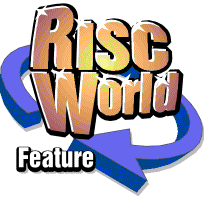



WebFX3D
RISCWorld presents the WebFX3D Manual.
| Scene Lighting |

WebFX3D provides some very powerful lighting facilities. From a users perspective, lighting is possibly the most complicated part of WebFX3D, as it requires an understanding of the 3D co-ordinate system , and Light Colours. We recommend that you store your scene in the gallery once lighting has been set so you can get the same settings in the future easily.
There are 4 views of the scene: 3 orthographic projections, and the 3D view. The projections include a plan (top left), front projection (bottom left) and right elevation (bottom right). Each projection shows the wireframe object, lights and the origin of 3D space. The wireframe is set to the colour of the object. You can change the background colour by clicking menu over a view and selecting background... if its too similar a colour to the wire frame colour.
The 3D view is a copy of the main 3D view. It provides a way to see how the lights affect the rendition of the object. If the main 3D view is set to wire frame display, click on the 3D view (in the lighting window) and it will be rendered. This is handy for slower computers which don't need the 3D view re-rendered every time you move a light, but only when you want to see how your changes look.
Working with lights
To add a light to the scene, simply drag the light icon (lower right of the window) to a projection. It will be created where you drop it and selected. To select a light, just click on it - the selected light is shown in yellow. To move a light, drag it to a different location (in the same view you dragged it from). To remove a light, drag it to the bin at the lower right of the window. There must be at least one light in the scene.
Ambient Light
The lighting which exists in a scene without any light sources present is called ambient light. In the real world ambient light is created when light is bounced off objects and reaches areas where there are no lights (such as day light reaching the ceiling of a room through a window). In WebFX3D, ambient light is constant for all faces of an object. Normally there is no ambient light (black), however you can set this by clicking on the Ambient light icon.
Edit Light
Click the Edit Light icon to edit the light colour and attenuation settings. For more information, see Editing a Light.
Zoom
Click on the zoom icon to open the zoom menu. This allows you to zoom in or out for all projection views. The zoom always scales the view by 2 or a half depending on the option (in or out). You can also press the + and - keys to zoom the views as a short cut.
Re-scale
The projection views can be re-scaled. This sets the scale and position of the projection views to fit all objects as closely as possible. Often you will need to zoom out after a re-scale to make room for moving the lights around.
See Also
Editing a Light
| Editing a Light |
In the Scene Lighting display, select a light to edit, and click the Edit light icon. The Light attributes dialog will open (shown below).

The name of the light in the dialog is not relevant in WebFX3D, but provides for expansion in the future. Ignore the Name field. The colour of the light can be set by clicking on edit... beside the colour. The light colour is set to white initially, for information on light colours see the reference section.
Attenuation refers to the way light becomes weak the further it gets from the light source (i.e. light from our Sun is strong as its close to the Earth, but light from stars is weak as they are far away). To turn attenuation on, tick the On option box. Start sets the distance up to which the light strength is full. The End distance sets where the light strength fades to no light at all.
You will have to adjust the distances until you get the desired effect. When ON, the light will have 2 circles drawn around it to show where the light starts to fade ( Start ), and where it fades to nothing ( End ).

The diagram above shows a light source. This emits light in all directions. When attenuation is On, the Start value defines the radius of the inner circle. The End value defines the radius of the outer circle.
See Also
Scene Lighting
RISCWorld